Amaryllis - Hippeastrum
 Amaryllis Symphony 'Rozetta' Picture courtesy www.hadeco.co.zaCondensed Version:
Amaryllis Symphony 'Rozetta' Picture courtesy www.hadeco.co.zaCondensed Version:
Amaryllis are commonly sold for the Christmas holiday season. Their magnificent trumpet-shaped blooms demand attention as they stand proudly facing outwards, atop tall thick stems, and come in fabulous shades of pink and magenta, to salmon, orange, red, and white. Varieties include single flowered, and many with stripes or contrasting edges, and the double flowers from Japan are particularly beautiful. New hybrids can produce huge flowers up to 22cm across, and a single stem will produce 4 flowers, and large bulbs may produce 2 stems. The latest (Sonatini hybrids) are true miniatures with blooms between 6 and 12cm across.
In the garden Amaryllis will grow in most good, well-drained soils, and enjoys sun to semi-shade. To make the flowers last longer in hot regions you need to plant them where the blooms are shaded at midday. Water your plants regularly in summer, never allowing the soil to dry out totally, and feed every two weeks during the growing season with a special bulb food or liquid fertiliser for flowering plants.
Bulbs grown in the garden can be left in the soil while dormant provided it is free draining and temperatures don’t drop below freezing in winter. The bulbs will continue to multiply and will only require dividing when they become overcrowded. If you live in the winter rainfall regions, or have a small garden, you may wish to lift and store the bulbs at the end of summer. Do this only once the foliage has died down naturally in autumn, as this is when the bulb is storing up reserves for the new flowers forming inside.
If you are planting bulbs into containers, it is best to do so before they begin to sprout, and if they are already showing signs of growth, it is important to plant them immediately. Amaryllis do not like big pots, preferring to fit snugly into smaller ones, so select a pot only 3cm larger in diameter than the bulb. Use a good potting mixture that drains very well, and plant so that the top third of the bulb is visible above the potting mixture. Place the pot in a warm location and water sparingly until the flower stem appears, then increase watering. Check your plants regularly, because flowering plants are thirsty. Because Amaryllis do not like standing in water, empty excess water from drip trays, and turn the pot regularly so that the plant grows straight.
Amaryllis bulbs take approximately 6 to 8 weeks to bloom once planted out. Deadhead individual spent flowers, and when all the flowers on a stalk are spent, cut it off at the base and allow the plant to continue growing. Towards the end of summer gradually reduce watering so that the leaves die back naturally. Once all the leaves are brown, cut them off and allow the bulb to rest by either leaving it in its pot without watering it, or by lifting and storing the bulb in a paper bag placed in a cool, dry place, for at least 2 months. When the bulb is ready to grow again it will start to produce a green leaf or stem, and can then be planted again in fresh soil and watered.
If you are growing your amaryllis indoors, planting and caring for them is the same as for potted specimens growing outdoors. Indoors they will require very good, bright light, and although they don’t need sun, a little sunlight won’t harm them either.
 Amaryllis 'Christmas Star' Picture courtesy www.hadeco.co.zaFull Version:
Amaryllis 'Christmas Star' Picture courtesy www.hadeco.co.zaFull Version:
Description, History & Interesting Facts:
Popular for their festive oversized flowers, amaryllis are commonly sold for the Christmas holiday season. Their magnificent trumpet-shaped blooms demand attention as they stand proudly facing outwards, atop tall thick stems, and come in fabulous shades of pink and magenta, to salmon, orange, red, and white. Varieties include single flowered, and many with stripes or contrasting edges, and the double flowers from Japan are particularly beautiful.
New hybrids can produce huge flowers up to 22cm across, and a single stem will produce 4 flowers, and large bulbs may produce 2 stems. The latest (Sonatini hybrids) are true miniatures with blooms between 6 and 12cm across. Although this may not sound small, for Amaryllis flowers it is, and what these miniatures lack in stature they more than make up for in generosity, with each bulb giving as many as 3 flower spikes, crowned with up to 6 delightful blooms each!
Amaryllis must be one of the easiest bulbs to grow, and most will bloom approximately five to six weeks after they are planted, and each bulb will generally produce at least four healthy leaves in order to bloom well next season. Some species will grow leaves and bloom at the same time, while others will grow leaves only after they have bloomed.
The plants we commonly call “Amaryllis” are actually Hippeastrum hybrids, and the name Amaryllis correctly belongs to our indigenous Amaryllis belladonna (Belladonna Lily) a genus with only one species, which can be found growing wild in the south-western Cape. Hippeastrums, on the other hand, hail from tropical and subtropical regions of the Americas, from Argentina north to Mexico and the Caribbean.
 Amaryllis 'Sonatini Assorted' Picture courtesy www.hadeco.co.zaIn the 18th century Dutch growers imported the first bulbs from South America to grow commercially, and this continued into the 19th century with even more botanists and explorers bringing back Hippeastrum species from South American countries. These magnificent blooms truly captured the imagination of plant breeders who worked diligently to create new hybrids and cultivars for the markets. Breeding developments continued throughout the second half of the 20th century, resulting in an explosion of new hybrids and types, in an expanded colour range. This period was also characterized by the establishment of many significant cultural research projects that resulted in the rapid expansion and professionalization of commercial hippeastrum cultivation.
Amaryllis 'Sonatini Assorted' Picture courtesy www.hadeco.co.zaIn the 18th century Dutch growers imported the first bulbs from South America to grow commercially, and this continued into the 19th century with even more botanists and explorers bringing back Hippeastrum species from South American countries. These magnificent blooms truly captured the imagination of plant breeders who worked diligently to create new hybrids and cultivars for the markets. Breeding developments continued throughout the second half of the 20th century, resulting in an explosion of new hybrids and types, in an expanded colour range. This period was also characterized by the establishment of many significant cultural research projects that resulted in the rapid expansion and professionalization of commercial hippeastrum cultivation.
In 1946 two Dutch growers moved to the Union of South Africa and began cultivation here, producing many beautiful hybrids for the world markets, and our bulb growers are still counted amongst the best in the world, with South African bred Hippeastrums being sought after across North and South America, all of Northern Europe, Japan, Russia and Iceland.
They never fail to delight and are certainly well worth investing in, and whether you are purchasing bulbs to plant out yourself, or those already in full bloom, these beauties are sure to steal your heart.
Amaryllis is a wonderful gift to give at any time of the year, but especially during the Christmas season, so spoil a friend, or yourself festive season with a selection of gorgeous Amaryllis - they are quite easy to grow if you understand their needs, and with good care you can enjoy their blooms year after year!
In the Garden & Home:
Amaryllis will add dramatic colour to homes and gardens, and make wonderful gifts for gardeners, from beginners to experts. Traditionally Amaryllis is grown in pots, but it can easily be grown in garden beds if you do not have problems with moles. For the best affect in the garden they need to be planted in groups.
Just like hyacinths, amaryllis bulbs can also be grown in a glass container filled with water , by simply placing the bulbs on top of pebbles or marbles, so the roots grow into the water, but the bulbs remain dry on top of the pebbles.
 Amaryllis Sonata Double 'Alfresco' Picture courtesy www.hadeco.co.zaCultivation/Propagation:
Amaryllis Sonata Double 'Alfresco' Picture courtesy www.hadeco.co.zaCultivation/Propagation:
In the garden Amaryllis will grow in most good, well-drained soils, and enjoys sun to semi-shade. To make the flowers last longer in hot regions you need to plant them where the blooms are shaded at midday. Water your plants regularly in summer, never allowing the soil to dry out totally, and feed every two weeks during the growing season with a special bulb food or liquid fertiliser for flowering plants.
Bulbs grown in the garden can be left in the soil while dormant provided it is free draining and temperatures don’t drop below freezing in winter. The bulbs will continue to multiply and will only require dividing when they become overcrowded. The mother bulb will produce small ‘bulblets’ and these can be gently teased off and potted, but they will take two or three years to flower again. It is not necessary to water dormant bulbs left in the soil from April to the end of August - wait for the new spring growth to emerge before feeding and watering again. However, if the soil has good drainage, the bulbs will not be damaged if watered lightly, together with other actively growing plants.
If you live in the winter rainfall regions, or have a small garden, you may wish to lift and store the bulbs at the end of summer. Do this only once the foliage has died down naturally in autumn, as this is when the bulb is storing up reserves for the new flowers forming inside.
If you are planting bulbs into containers, it is best to do so before they begin to sprout, and if they are already showing signs of growth, it is important to plant them immediately. Amaryllis do not like big pots, preferring to fit snugly into smaller ones, so select a pot only 3cm larger in diameter than the bulb. Use a good potting mixture that drains very well, and plant so that the top third of the bulb is visible above the potting mixture. Place the pot in a warm location and to prevent root rot, water sparingly until the flower stem appears, then increase watering. Check your plants regularly, because flowering plants are thirsty. Because Amaryllis do not like standing in water, empty excess water from drip trays, and turn the pot regularly so that the plant grows straight. Deadhead individual spent flowers, and when all the flowers on a stalk are spent, cut it off at the base and allow the plant to continue growing.
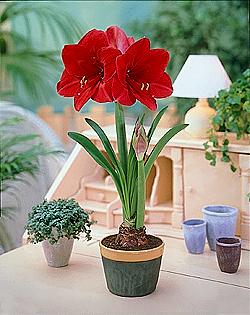 Amaryllis 'Miracle' Picture courtesy www.hadeco.co.zaWhen your potted plants are in full bloom, you may prefer to move them indoors to enjoy, or you may move then into a more shady and secluded spot outdoors, which will keep the blooms looking good for longer. Once the leaves have died down naturally at the end of summer, the containers can be moved into a sheltered part of the garden where it is relatively dry and warm, to over-winter.
Amaryllis 'Miracle' Picture courtesy www.hadeco.co.zaWhen your potted plants are in full bloom, you may prefer to move them indoors to enjoy, or you may move then into a more shady and secluded spot outdoors, which will keep the blooms looking good for longer. Once the leaves have died down naturally at the end of summer, the containers can be moved into a sheltered part of the garden where it is relatively dry and warm, to over-winter.
Amaryllis bulbs take approximately 6 to 8 weeks to bloom once planted out, and if you want blooms at Christmas time, plant them out around the 10th of November. This can be done by manipulating the bulbs to flower at a specific time, by placing them in a paper packet and storing them in the refrigerator. This tricks the bulbs into thinking that it is still winter and they remain dormant. Check the stored bulbs regularly, and if they do start shooting, plant them out immediately.
During summer, allow the leaves to continue to grow and nourish the bulb, and continue to water and fertilise the plant. Towards the end of summer gradually reduce watering so that the leaves die back naturally. Once all the leaves are brown, cut them off and allow the bulb to rest by either leaving it in its pot without watering it, or by lifting and storing the bulb in a paper bag placed in a cool, dry place, for at least 2 months. When the bulb is ready to grow again it will start to produce a green leaf or stem, and can then be planted again in fresh soil.
If you are growing your amaryllis indoors, planting and caring for them is the same as for potted specimens growing outdoors. Indoors they will require very good, bright light, and although they don’t need sun, a little sunlight won’t harm them either. To prevent root rot, water sparingly until the flower stem appears, but when it starts to grow, increase the amount of water you give, and check your plants regularly, because flowering plants are thirsty.
Like hyacinths, amaryllis bulbs can be grown on water. Place the bulbs on top of pebbles or marbles in a glass container and fill with water until just beneath the bulb, and the roots will grow into the water. Amaryllis bulbs grown this way should be discarded once they have finished blooming.
Good amaryllis care will ensure that you enjoy beautiful blooms year after year.
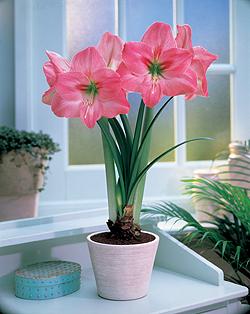 Amaryllis 'Blushing Bride' Picture courtesy www.hadeco.co.zaProblems, Pests & Diseases:
Amaryllis 'Blushing Bride' Picture courtesy www.hadeco.co.zaProblems, Pests & Diseases:
Long stems and flower heads that fall over could be the result of the plant not getting enough light, overwatering, or being exposed to temperatures that are too low. Next year, place your potted amaryllis in a sunnier, warmer position, hold back on water and try rotating the container every few days.
Hand-pick and destroy snails and slugs as well as the black and yellow amaryllis caterpillar or lily borer which eats the leaves and bores down into the bulb.
Red blotches on the leaves are caused by fungi known as Stagonospora curtisii. Try cutting off the affected part of the leaf as soon as you spot signs of this disease.
Warning:
Amaryllis contains the toxic alkaloid lycorine, which can cause symptoms in pets ranging from vomiting, depression, diarrhoea and abdominal pain to excessive drooling, anorexia and tremors. If your cat or dog is showing symptoms of lycorine poisoning, call your local vet. In humans, eating an amaryllis bulb may cause symptoms such as nausea, vomiting, salivation and diarrhoea. North Carolina State University claims that the plant is toxic only if large quantities are ingested.
Epidendrum Orchid
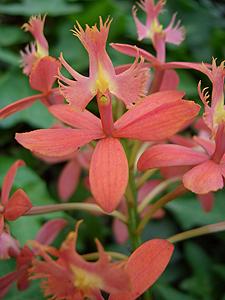 Epidendrum 'Salmon' These small beauties are fairly easy to grow and come from Central and South America, there are about 1 000 recognised species. Many of them grow in grasslands, often in full sun, others grow on trees. They can flower all year round and come in shades of red, white, orange, yellow and purple.
Epidendrum 'Salmon' These small beauties are fairly easy to grow and come from Central and South America, there are about 1 000 recognised species. Many of them grow in grasslands, often in full sun, others grow on trees. They can flower all year round and come in shades of red, white, orange, yellow and purple.
They are grown outdoors in warm, moist, temperate regions, but must be grown indoors in cold areas. Plant them in very bright light. Feed them with any orchid food once a month and water them when they are almost totally dry, about twice a week in summer and once a week in winter. In dry regions, mist spray your plant down often with rainwater.
...................................................................................................................................
Dancing Lady Orchid - Oncidium
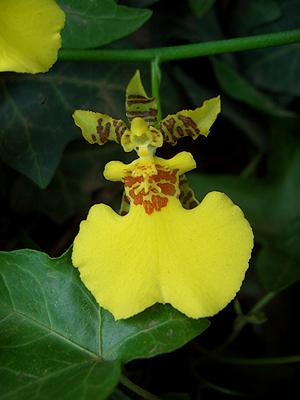 Oncidium 'Yellow' Background leaves are Ivy. There are over 650 different species of these beauties from tropical America. They can be grown outdoors in warm, moist, temperate regions, but must be grown indoors in cold areas. They prefer a cooler position with bright light, (60% shade outdoors). Feed them with any orchid food monthly.
Oncidium 'Yellow' Background leaves are Ivy. There are over 650 different species of these beauties from tropical America. They can be grown outdoors in warm, moist, temperate regions, but must be grown indoors in cold areas. They prefer a cooler position with bright light, (60% shade outdoors). Feed them with any orchid food monthly.
Most species are grown mounted, or in baskets, which allow inimpeded development of the root system and allows the roots to dry out quickly after watering. Water them twice a week in summer and once a week in winter, allowing them to partially dry out between watering. They love constant humidity, so collect rainwater to spray them down with frequently, especially in dry areas. The flower sprays will grow +- 120cm long and it will grow +-90cm wide.
Colmonara Orchid
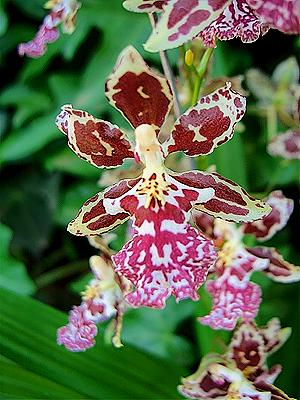 These beauties are grown for their rich colours and striking patterns. They grow outdoors in warm, humid, moist regions but prefer a cooler position (70% shade), with good light. Colomnara bear tall flower spikes +-20 to 75cm tall and will spread +- 20 to 30cm wide. In cold areas they must be grown indoors.
These beauties are grown for their rich colours and striking patterns. They grow outdoors in warm, humid, moist regions but prefer a cooler position (70% shade), with good light. Colomnara bear tall flower spikes +-20 to 75cm tall and will spread +- 20 to 30cm wide. In cold areas they must be grown indoors.
Water them regularly all year round, never allowing the roots to dry out.Feed them once a month with any orchid food. They love humidity, so collect rainwater to water and spray them with, especially in dry regions.
Vanda Orchid
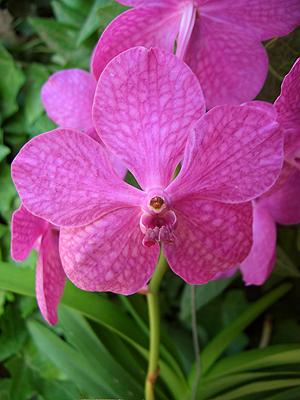
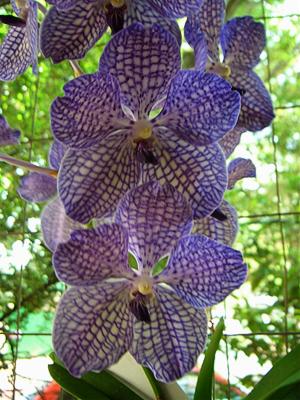 This genus of orchids, with about 50 species comes from Sri Lanka and India, across Southeast Asia to New Guinea and Northeastern Australia, where they grow on rocks and trees. They can flower almost all year round and the flowers are long lasting and often highly fragrant. Most modern hybrids come from V. sanderiana and V. coerulea.
This genus of orchids, with about 50 species comes from Sri Lanka and India, across Southeast Asia to New Guinea and Northeastern Australia, where they grow on rocks and trees. They can flower almost all year round and the flowers are long lasting and often highly fragrant. Most modern hybrids come from V. sanderiana and V. coerulea.
These orchids enjoy humidity, bright light and warm temperatures all year round. They must have free air circulation, without draughts, excellent drainage and are therefore grown in coarse bark. Allow them to dry out between watering. In summer, water them well, 4 to 5 times per week and in winter water them less, 2 to 3 times per week; especially in cold areas. Healthy plants develop thick white roots. Collect rainwater to spray the leaves down with. In cold regions ensure that the night temperature does not drop below 18 degrees C. They can be grown outdoors in warm, moist temperate regions, in semi-shade to sun.
Grow them indoors in cold areas ensure that the night temperature does not drop below 18 degrees C. Re-pot at any time in subtropical and tropical regions, and in spring in cold regions. Feed them monthly with any orchid food. They vary in height from +-20 to 50cm wide and +-20 to 120cm tall.
Lady's Slipper Orchid - Paphiopedilum hybrids
 Slipper OrchidsThese orchids are native to Eastern Asia, the Philippines, Malaysia and Malucca, where they are mainly terrestrial, but sometimes epiphytic. They are continually being hybridised and new varieties released.
Slipper OrchidsThese orchids are native to Eastern Asia, the Philippines, Malaysia and Malucca, where they are mainly terrestrial, but sometimes epiphytic. They are continually being hybridised and new varieties released.
Slipper orchids make good houseplants as they do not require as much light as other orchids. They will grow +- 300 to 600mm tall.
They can be grown outdoors in warm, moist, temperate regions in about 70% shade; as too much light will inhibit their flowering. They must be grown indoors in cold or dry regions. The green leaved varieties will tolerate a minimum night temperature of +-10 degrees C and the mottled varieties +-18 degrees C. An occasional drop in temperature to 4 degrees C will not damage your plants. They are both happiest in daytime temperatures of between 20 to 26 degrees C, but will tolerate short hot spells of up to 37 degrees C.
Place them in a well-ventilated position; with no draughts and pot them into small pots with a well-drained orchid mix. The soil should never be allowed to dry out. Re-pot every two years or so, in spring. Feed with any orchid food monthly and try to water your plant and mist spray the leaves often with rain water.
Pansy Orchid - Miltoniopsis
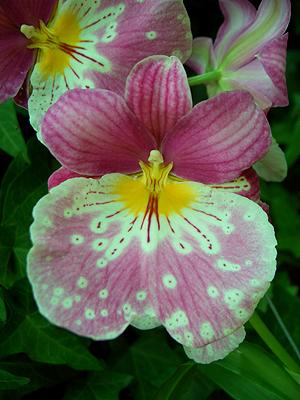
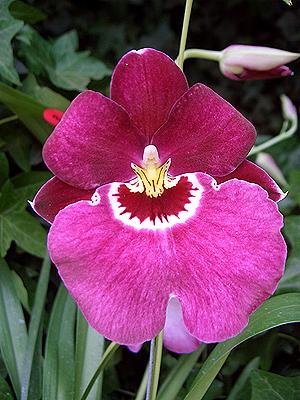 These orchids come mainly from Colombia and Ecuador and have very specific needs. They love humidity but in a shaded, cooler position, (60 to 70% shade), with ample air movement, but no draughts. Grow them in small pots, in a special orchid mix, (available at your local nursery.)
These orchids come mainly from Colombia and Ecuador and have very specific needs. They love humidity but in a shaded, cooler position, (60 to 70% shade), with ample air movement, but no draughts. Grow them in small pots, in a special orchid mix, (available at your local nursery.)
In dry regions, mist them down regularly with rain water. Water them twice a week in summer and once a week in winter, with rainwater, if possible. If you dont have rainwater, use tap water, but let it stand for a couple of days before using it. Feed them once a month with any orchid food.
Pansy Orchids grow outdoors in warm, moist, temperate regions, but must be grown as an indoor pot plant in cold areas.
Cymbidium Orchid
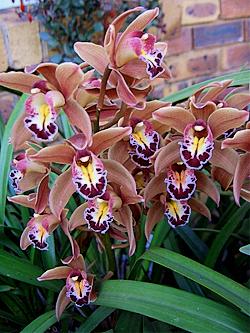 Condensed Version:
Condensed Version:
Often we are given orchids as gifts, or just can’t resist buying them ourselves when they are in full bloom. The problem is what do we do with them when they are finished blooming indoors? Cymbidiums are easy to grow indoors and outdoors and a good choice for the amateur grower because they tolerate a wide range of growing conditions. However, in order to flower beautifully it is vital that these orchids are placed in the right amount of light, both indoors and outdoors. They love bright, diffused light, but no strong direct sunlight. The colour of the leaves will give you a good indication if the light is correct; they should be slightly yellow-green; deep green leaves indicate that the plant is receiving too much shade. Cymbidiums will grow happily in dappled shade underneath trees, shrubs and perennials; and can be watered and fed in the same way as your other plants. They also tolerate cold temperatures if planted underneath the eaves of the house, on the patio, or underneath evergreen shrubs and trees. Protect them from severe frost and cold winter winds which will damage the flowers. Cymbidiums can become quite large, so allow them space to grow and give them adequate air circulation. Miniature Cymbidiums will tolerate less difference in daytime temperatures and are therefore more suitable for growing in warmer regions and at the coast.
Water your potted plants and those growing in garden beds about three times a week in summer; keeping the growing medium slightly moist but not soggy. Reduce watering in winter to help initiate flower spikes. Mist spray the plants often during hot, dry weather, or stand potted plants in trays filled with damp gravel. Potted plants should be fed regularly with a special orchid food; those growing in the garden can also be fed with a specialist feeder, or you can feed them in summer with the same fertilisers you use on other flowering plants. In winter the change in temperature initiates the flower spikes, so start feeding already in autumn with a feeder high in potassium. There are many mixtures available for growing cymbidiums, such as pine bark, compost, rock wool, peanut shells etc. Any good orchid mixture is fine as long as it is relatively water retentive, yet still drains well. If you are growing your plants in garden beds, incorporate lots of compost and any of the above to ensure that drainage is excellent.
Full Version:
Description, History & Interesting Facts:
The genus Cymbidium in the Orchid family consists of about 50 species native to southern and eastern Asia and Australia; where in their natural habitat they often attach themselves to trees. Thousands of hybrids have been bred over the past century and cymbidiums now come in all colours except true red and blue. They flower for many months from July to December and are available in stunning shades of pink, maroon, yellow, orange, green and copper. Cymbidiums are grown as long lasting cut flowers.
Uses:
Besides being excellent for the vase, these orchids are non-toxic and edible. In fact, in South Asia's Bhutan, where they are called ‘olachotho’, they are part of the local diet and considered a delicacy. The most common method of cooking ‘olachotho’ in Bhutan is with cheese. The flowers (unopened or opened) are separated from the inflorescence and washed with water. The cleaned flowers are then boiled in water for 10 minutes till slightly soft. A local cheese is then added together with salt and chillies and simmered until tender. Olachotho is usually served with local brown rice. This orchid is quite bitter and needs to be cooked in a way that tempers the bitterness; garlic, onions and tomatoes also go well with Cymbidium, as does mustard seed and turmeric. The flowers and leaves are also edible and villagers eat the cooked pseudo bulbs with a bit of salt, much like a potato.
In the Garden and Home:
Cymbidiums are tolerant of a wide range of conditions and good choice for the amateur grower. Light and water are the most important factors in growing healthy plants that flower well; together with regular feeding. They can be placed indoors or outdoors and will tolerate moderate frost if planted underneath the eaves of the house, on the patio, or underneath evergreen shrubs and trees. Protect them from severe frost and cold winter winds which will damage the flowers.
 Cultivation:
Cultivation:
It is vital that these orchids are placed in the right amount of light both indoors and outdoors in order to flower beautifully. They love bright, diffused light, but no strong direct sunlight. The colour of the leaves will give you a good indication if the light is correct. They should be slightly yellow-green; deep green leaves indicate that the plant is receiving too much shade.
Water your potted plants and those growing in garden beds about three times a week in summer; keeping the growing medium slightly moist but not soggy. Reduce watering in winter to help initiate flower spikes. Mist spray the plants often during hot, dry weather, or stand potted plants in trays filled with damp gravel. Potted plants should be fed regularly with a special orchid food; those growing in the garden can also be fed with a specialist feeder or you can feed them in summer with the same fertilisers you use on other flowering plants. The change in temperature in winter initiates the flower spikes; so start feeding already in autumn with a feeder high in potassium.
There are many mixtures available for growing cymbidiums, such as pine bark, compost, rock wool, peanut shells etc. Any good orchid mixture is fine as long as it is relatively water retentive, but still drains well. If you are growing your plants in garden beds, incorporate lots of compost and any of the above to ensure that drainage is excellent.
Cymbidiums can become quite large, so allow them space to grow and give them adequate air circulation. Miniature Cymbidiums will tolerate less difference in daytime temperatures and are therefore more suitable for growing in warmer regions and at the coast.
Propagation:
If your plant is overcrowded or pot bound it can be split and re-potted in spring when it has finished flowering. Always leave 3 or 4 pseudo bulbs on every piece to supply nutrients to the plant for the season. Use a container large enough to allow for another 2 years growth. Remove any dead or dying plant material and gently shake off any excess, old potting mix. The old pseudo bulbs, which are called back-bulbs, can be removed and their base inserted into river sand, to encourage new roots to form.
Pests & Diseases:
Cymbidiums are relatively pest and disease free but pests such as snails and slugs, mealy bugs, red spider mites and scale insects may attack orchids. In addition, aphids are attracted to the flowers and buds. Use caution when using any insecticide to rid orchids of pests. An insecticidal soap or insecticide with a spreader sticker (substances added to pesticides to make them spread and stick to a surface more easily) can be used on the leaves to control pests but should not be used on the flowers or buds as this could result in deformation of the blooms.
Warning:
Cymbidium orchids are non-toxic and are actually edible. While allergies to orchids may be rare, there have been reported cases of contact dermatitis from orchids. People can develop sensitivities to plants so they should be aware if they develop skin problems. Cymbidium orchids are not listed as a toxic plant for cats or dogs. However, generally it is recommended that animals not be allowed to munch on plants, as ingesting plant materials could cause vomiting or diarrhoea.
Moth Orchid - Phalaenopsis hybrids
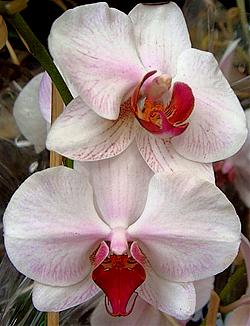 Condensed Version:
Condensed Version:
The exquisite moth orchids are popular among novice and experienced growers alike because they are easy to grow and adaptable to many different types of environments. Most are epiphytic shade plants (epiphytic plants derive moisture and nutrients from the air and rain; usually growing on another plants but not parasitic on them). Modern breeding programs have brought about enormous changes in plants for the mass market, with true miniature plants flowering in 6cm pots, to multi-floral types that bloom several times a year, to large plants with enormous leaf spans and flower stems up to 1m long. Besides the commonly seen pink and white varieties, hybrids with yellow, red and purple shades are also available.
Moth orchids generally like the light and temperature condition of our homes; making them an excellent choice for first time orchid growers; and most suitable for city dwellers who have limited space, or no garden at all. Orchids have the added advantage of being one of the few plants that produce oxygen at night, so are highly recommended for bedrooms. It is also possible to grow moth orchids outdoors in warm frost-free and Mediterranean climates; and if properly cared for they can be among the showiest and most exotic of all garden or patio plants.
Phalaenopsis are low light orchids, and although light is quite vital to the well-being of the plant, ensure that the plant is not in direct sunlight as this will cause the leaves to burn. On the other hand, specimens grown in very dark areas tend to grow floppy dark green leaves and rarely flower. The leaves should be olive green; if they are darker it means the plant is not getting enough light; red tinged leaves mean the plant is getting too much light. Once the plant is in bloom you can place it anywhere in your home out of direct sunlight and draughts. Moth orchids like high humidity (60 to 70%) so mist your plant regularly with tepid water and use a shallow tray of pebbles filled with water to increase humidity around your plants, but ensure that the pot does not sit in water. The higher the humidity, the more important it is to maintain a good air flow around the roots and leaves. Keep in mind that temperatures close to the window on a windowsill will be colder or hotter than your general house temperature; and fluctuating temperatures can cause bud drop on plants with buds ready to open.
These orchids are usually potted in a well-drained bark mixture but can also be cultivated in sphagnum moss, or mounted on wood. One of the most deadly blunders that new growers make is to over water; and this together with bad drainage will cause the roots to deteriorate and eventually rot, killing the plant. How often you water will depend on the potting medium and how much light and heat your plant receives. Bark retains less water than moss; so if your orchid is potted in bark watering once a week is generally sufficient. Moss retains more water, so watering will be less often, or when the moss feels dry. During the growth season, water the plant whenever its exposed roots turn silvery white; and during the flowering season, you can cut the water back to every other week. Use tepid water (rainwater is excellent) but do not use salt-softened or distilled water. Let the water run through the plant for a minute or so; and be sure to let the plant drain completely afterwards; wiping away any water which may have collected in the centre of the plant to prevent crown rot. During the growing season, fertilise with a specialist orchid fertiliser as directed, but feed sparingly during the winter months. The plants do need the occasional 'flushing out'; so with every fourth watering use only plain water (with no fertiliser) to ensure that any potentially harmful accumulations of salts are leached from the potting medium.
Successful growth means finding the right balance between humidity, temperature, light and air flow.
 Full Version:
Full Version:
Description, History & Interesting Facts:
The exquisite moth orchids are popular among novice and experienced growers alike because they are easy to grow and produce the elegant arching sprays of long-lasting blooms that can be seen in so many design magazines across the world. The name Phalaenopsis is derived from the Greek and means "resembling a moth." It was so named because the white and pink species growing on trees in the wild resemble flights of moths at twilight.
Phalaenopsis is a genus of approximately 60 species of orchids from the tropics, but from widely diverse climates within the tropics. Some species come from seasonally dry areas in Thailand or Burma; while others are wet-rainforest species from the Philippines, Malaysia or Indonesia. They are native throughout south-east Asia from the Himalayan Mountains to the islands of Polillo and Palawan of the Philippines, and northern Australia. Orchid Island off Taiwan is named after this orchid.
In tropical climates they tend to grow on tree branches and between rocks, usually near a source of water for moisture. Aside from rainforest climates, they also grow in grassland areas such as pastures. These orchids are adaptable to many different types of environments which is one of the reasons they are so easy to maintain!
Most are epiphytic shade plants (epiphytic plants derive moisture and nutrients from the air and rain; usually growing on another plants, but not parasitic on them) a few are lithophytes (plants that grow on rocks, deriving their nourishment chiefly from the atmosphere.) In the wild they are typically found below the canopies of moist and humid lowland forests, protected against direct sunlight, but equally in seasonally dry or cool environments. The species have adapted individually to these habitats.
Moth orchids were among the first tropical orchids to be grown in Victorian collections; and most of the Phalaenopsis plants offered for sale today are the result of many generations of breeding from species that are native to eastern Asia. Because these hybrids are one of the easiest orchids to grow in the home and flower well under artificial conditions, moth orchids quickly became one of the most popular orchids sold as potted plants. Under optimal growing conditions, and once mature, these hybrids generally bear from twelve to twenty (and quite often more) flowers.
Modern breeding programs have brought about enormous changes in plants for the mass market, with true miniature plants flowering in 6cm pots, to multi-floral types that flower several times a year, to large plants with enormous leaf spans and flower stems up to 1m long. There is a moth orchid for almost any culture, space, condition and colour taste. Besides the commonly seen pink and white varieties; advances in hybridizing have produced yellow, red and purple shades as well. Although many new hybrids are introduced every year, most Phalaenopsis offered for sale are unnamed hybrids and only specialist orchid growers will offer named species and hybrids.
Phalaenopsis schilleriana and Phalaenopsis stuartiana are two species that produce multitudes of flowers; and the small novelty types such as Phalaenopsis sumatrana, Phalaenopsis bellina/violacea, and Phalaenopsis lueddemanniana bear fewer flowers on much shorter stems. Phalaenopsis schilleriana produces deep rose-pink blooms flushed with white up to 8cm across, with silver-mottled dark green leaves. Phalaenopsis equestris produces clusters of 10 to 15 small pink flowers, each 2.5cm across, with fresh green leaves. Phalaenopsis cornu-cervi has spidery yellow flowers spotted with dark red, each 2.5 to 3.5cm across, in clusters of about 12 blooms that open successively.
Phalaenopsis is a monopodial orchid that grows from a single stem. Orchids with monopodial growth often produce copious aerial roots that hang down in long drapes and have green chlorophyll underneath the grey root coverings, which are used as additional photosynthetic organs. Because they do not have a rhizome or pseudo bulbs, the species adapted to dry periods by evolving fleshy succulent leaves instead. Flowers generally come from the stem between the leaves; and the plant produces about two sets of alternate, thick and fleshy elliptical leaves a year; the older basal leaves drop off at the same rate; so the plant commonly retains only four to five leaves all the time; if very healthy, they can have up to ten or more leaves.
In the Home & Garden:
Moth orchids are quite easy to grow, and generally like the light and temperature condition of our homes, making them an excellent choice for ‘first time’ orchid growers, and most suitable for city dwellers who have limited space. If kept in the home, moth orchid flowers usually last two to three months, which is considered quite a long time; mature specimens grown in ideal conditions can bloom for much of the year.
The modern home is prone to all manner of insidious toxins, such as formaldehyde (from carpets, plywood, flat-pack furniture and insulation materials); benzene (from particleboard and some paints); propanol (cleaning products); and dichloromethane (paint thinners and strippers), whose effects can range from mild eye, nose and throat irritations to more serious conditions.
We can all probably remember enough biology to know that plants take in carbon dioxide and give off health-giving oxygen and water vapour as part of the photosynthesis process. It might seem unlikely that mere houseplants could provide a defence, but studies have found some to be particularly effective.
Orchids in particular have the added advantage of being one of the few plants that produce oxygen at night, so the moth orchid is therefore highly recommended for bedrooms. It is also possible to grow moth orchids outdoors in warm frost-free and Mediterranean climates; and if properly cared for they can be among the showiest and most exotic of all garden or patio plants.
 Growing moth orchids indoors:
Growing moth orchids indoors:
If kept in the home, moth orchid flowers usually last two to three months, but mature specimens grown in ideal conditions can bloom for much of the year. An added advantage of growing orchids is that they are one of the few plants that continue producing oxygen at night, and are therefore highly recommended for bedrooms.
When grown indoors it is pertinent to remember that in nature moth orchids are typically fond of warm temperatures between 20 to 35°C, and although they are adaptable to temperatures ranging from 15 to 35°C, at temperatures below 18°C watering should be reduced to avoid the risk of root rot. Flowering is triggered by a night-time drop in temperature of around 5 to 6 degrees over 2 to 4 consecutive weeks, usually in autumn.
One of the most important points to consider when growing moth orchids is light, and although light is quite vital to the well-being of the plant, Phalaenopsis are essentially low light orchids, and direct sunlight will cause the leaves to burn. The leaves should be olive green, and if they are darker it means the plant is not getting enough light. On the other hand, red tinged leaves mean the plant is getting too much light. Once the plant is in bloom you can place it anywhere in your home to show it off, as long as the area is out of direct sunlight and draughts.
Moth orchids like high humidity (60 to 70%) so mist your plant regularly with tepid water and use a shallow tray of pebbles filled with water to increase humidity around your plants, but ensure that the pot does not sit in water. A humidifier is also most effective indoors. The higher the humidity, the more important it is to maintain a good air flow around the roots and leaves. Keep in mind that temperatures close to a window on a windowsill will be colder or hotter than your general house temperature; and fluctuating temperatures can cause bud drop on plants with buds ready to open.
These orchids are usually potted in a well-drained bark mixture but can also be potted in sphagnum moss or mounted on wood. One of the most deadly blunders that new growers make is to overwater, and this together with bad drainage will cause the roots to deteriorate and eventually rot, killing the plant.
How often you water will depend on the potting medium and how much light and heat your plant receives. Bark retains less water than moss; so if your orchid is potted in bark watering once a week is generally sufficient. Moss retains more water, so watering will be less frequent, or when the moss feels dry. During the growth season, water the plant whenever its exposed roots turn silvery white, usually weekly. During the flowering season, you can cut the water back to every other week.
It is best to water in the morning, and to prevent crown rot, and indoors it is good to wipe away any water which may collect in the centre of the plant. Use tepid water (rainwater is excellent) but do not use salt-softened or distilled water. Let the water run through the plant for a minute or so, and be sure to let the plant drain completely afterwards.
During the growing season fertilise with a specialist orchid fertiliser as directed, but feed sparingly during the winter months. The plants do need the occasional 'flushing out', so with every fourth watering use only plain water (with no fertiliser) to ensure that any potentially harmful accumulations of salts are leached from the potting medium
When the blooms are finished, you can cut the spike down to the level of the leaves and the plant will bloom again within a year. You can also cut off the stem leaving two nodes on the stem (nodes are those little brown lines on the stem below where the flowers were.) One of these nodes may initiate and produce flowers again within 8 to 12 weeks. Continue watering and fertilising while you are waiting for the blooming cycle to begin again. If a plant is large and healthy but does not produce flowers in a reasonable time, then reduce the temperature by 5°C for four weeks, and a flower spike will usually develop.
For healthy root growth, repot every couple of years before the potting mix has started to disintegrate. Do this when the plant has finished blooming but do not be tempted to repot into too large a pot, rather choose a pot just large enough to contain the roots. Do not try to bury the fleshy white aerial roots that extend above the pot, as they are prone to rotting.
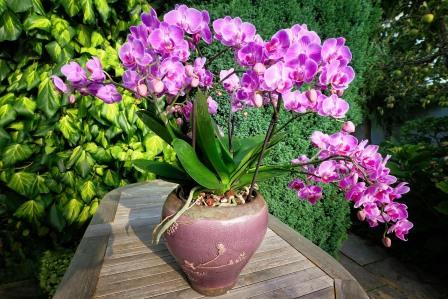 Moth orchid. Image by Albrecht Fietz from PixabayGrowing moth orchids outdoors:
Moth orchid. Image by Albrecht Fietz from PixabayGrowing moth orchids outdoors:
It is also possible to grow moth orchids outdoors in warm, humid, frost-free, and Mediterranean climates, and if properly cared for they can be among the showiest and most exotic of all garden or patio plants.
Moth orchids are epiphytes and cannot be planted directly in the ground outdoors; rather mount them on trees, wooden stumps or rocks, or grow them in containers, hanging baskets, or raised beds, filled with a potting media specifically formulated for these orchids. When mounting or planting your orchids take extra care to make sure the plants are tilted so that water quickly runs out of the crowns.
Growing plants in sphagnum moss in slatted baskets is another very successful way to cultivate moth orchids outdoors, because for those species that want extra moisture the roots will stay inside the moist moss; and for those which require drier roots, the roots will naturally head out onto the basket surfaces and sometimes even grow completely outside the moss
Moth orchids scorch easily in the sun and should be grown in good light but complete shade. Although they like good ventilation around their roots and leaves, they will need protection from strong winds and excessive rainfall. Moth orchids grown outdoors will also need regular watering during dry periods and fertilising with a specific orchid food. While regular watering is appreciated, wet and soggy roots systems and media are to be avoided. Successful growth outdoors means finding the right balance between humidity, temperature, light, and air flow.
Propagation:
Sometimes small plantlets (keiki) appear from the nodes on the flower stems. Detach the plantlets when they have developed several good roots and pot them up in orchid mix. Water sparingly at first, but mist spray daily. Production of offsets can be encouraged by application of keiki paste (a specialist hormone preparation obtained from specialist orchid suppliers) to the nodes of the spent flower spike. Ordinary hormone rooting compound will not do. With a scalpel make a vertical cut through the bract covering the node. Do not cut into the bud beneath. With tweezers pull away the two halves of the bract and apply a little keiki paste to the exposed bud. After six to eight weeks little plantlets may be produced.
 Problems, Pests & Diseases:
Problems, Pests & Diseases:
If grown correctly these orchids are more pest free than most genera, but watch out for spider mites, thrips, scale, mealy bugs and aphids.
Bud blasting is a common problem with Phalaenopsis, but fortunately there is almost always a reason that can be determined for this condition. There are many factors that can cause buds to dry up and drop off the plants without ever opening. Check that the room you are growing your orchid in is not excessively hot and dry or the light level too low. Also, ensure that you are watering correctly and not over fertilising. The plant also dislikes cool draughts and very strong fumes emitted from fresh paint, carpets, refinishing woodwork, etc.
Toxicity:
The moth orchid is non-toxic to humans, dogs, cats and horses, but it is always advisable to supervise young children and pets around plants.
Poinsettia, Karlienblom, Crown of the Andes, Flor de Pascua, Noche Buena - Euphorbia pulcherrima
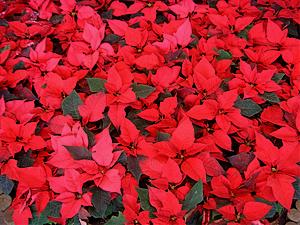 Condensed Version:
Condensed Version:
Poinsettia is a small deciduous tropical tree or shrub with dark green dentate leaves. Today there are over 100 cultivated varieties of poinsettia and they are immensely popular garden plants in tropical or subtropical gardens. In these regions it becomes a woody perennial that can be pruned into a shrub or small tree up to 4m high. Plant them in full sun and in well-drained soil; fertilise monthly during the growing season with a balanced fertiliser for flowers and prune hard after they have finished blooming.
The coloured bracts are most commonly red but can be orange, lime-green, cream, pink, white or marbled; the small clusters of yellow flowers are unassuming. In areas outside their natural environment poinsettias are commonly grown as indoor pot plants. They are easy to maintain and will last for a few months indoors making them popular Christmas decorations. Poinsettias are mostly disposed of once they start to fade, but you can keep them all year and the bracts will colour up again if they are cared for correctly.
Because poinsettias are tropical plants, in cold regions they are grown in greenhouses at temperatures of about 17 to 20°C, so this temperature range in the home is best for long plant life. Place your potted poinsettia near a sunny window or any well-lit area, out of direct sunlight. Ensure that the spot you have chosen is not too hot because high temperatures will shorten the  Pink and Cream Poinsettia. Image by sandid from Pixabaylife of the bracts. Poinsettias also don’t like hot or cold drafts, so keep them away from fans as well as open windows or doors.
Pink and Cream Poinsettia. Image by sandid from Pixabaylife of the bracts. Poinsettias also don’t like hot or cold drafts, so keep them away from fans as well as open windows or doors.
The flowering life of the plants is extended by humidity, so mist your plants regularly with tepid water. The most common mistake is too over water them indoors; causing the leaves to turn yellow and drop. Allow the soil to dry out between watering, but examine the soil every day because under watering will cause the plant to wilt, and the lower leaves will drop. Always water enough to soak the soil to the bottom of the pot but it is very important to discard the excess water from the drip tray or your plant will rot. If you keep your plant for several months, apply a soluble high potassium houseplant fertiliser once a month.
Full Version:
Description, History & Interesting Facts:
Poinsettia is a small deciduous tropical tree or shrub of the diverse spurge family; cultivated for its striking red bracts, with potted forms being the basis of a lucrative Christmas industry. It derives its common English name from the first United States Minister to Mexico, Joel Roberts Poinsett, who introduced the plant into the United States in 1825.
It is indigenous to Mexico where it grows wild in deciduous tropical forests, at moderate elevations from southern Sinaloa down the entire Pacific coast of Mexico to Chiapas and Guatemala. It is also found in the  Red and White Poinsettia. Image by Michael Bubmann from Pixabayinterior, in the hot and seasonally dry forests of Guerrero, Oaxaca, and Chiapas.
Red and White Poinsettia. Image by Michael Bubmann from Pixabayinterior, in the hot and seasonally dry forests of Guerrero, Oaxaca, and Chiapas.
The plant's association with Christmas began in 16th century Mexico, where legend tells of a girl who was too poor to provide a gift for the celebration of Jesus' birthday. The tale goes that the child was inspired by an angel to gather weeds from the roadside and place them in front of the church altar. Crimson "blossoms" sprouted from the weeds and became beautiful poinsettias. Franciscan friars in Mexico included the plants in their Christmas celebrations - the star-shaped leaf pattern is said to symbolize the star of Bethlehem, and the red colour the blood sacrifice through the crucifixion of Jesus.
In the language of the Aztecs the plant is called Cuetlaxochitl; meaning "flower that grows in residues or soil;" and they used it to produce red dye and medicinally to treat pain and fever. Today it is known in Mexico as "Noche Buena," meaning “flower of Christmas Eve. “ In Spain, Puerto Rico, Guatemala and other Central America countries it is known as "Flor de Pascua" or "Pascua" meaning "Easter flower." In Chile and Peru, the plant became known as "Crown of the Andes".
Atatürk, the founder of the Republic of Turkey loved poinsettia, and it soon became widespread in cultivation there and today it is still called "Atatürk's flower." The poinsettia has also been cultivated in Egypt since the 1860s.
 Poinsettia in the garden. Image By Thanks for Your like Donations welcome from PixabayAlbert Ecke, who immigrated to America from Germany in 1900 and settled in Los Angeles became so intrigued with poinsettias that he started selling them from street stands, and later his son Paul developed the grafting technique, but it was the third generation of Eckes, Paul Ecke Jr. who was responsible for marketing the association between the plant and Christmas; sending free plants to television stations to decorate their sets from Thanksgiving to Christmas. He also appeared on television programs like The Tonight Show and Bob Hope's Christmas specials to promote the plants. Needless to say this brilliant marketing strategy paid off and the Ecke family moved their operation to Encinitas, California in 1923.
Poinsettia in the garden. Image By Thanks for Your like Donations welcome from PixabayAlbert Ecke, who immigrated to America from Germany in 1900 and settled in Los Angeles became so intrigued with poinsettias that he started selling them from street stands, and later his son Paul developed the grafting technique, but it was the third generation of Eckes, Paul Ecke Jr. who was responsible for marketing the association between the plant and Christmas; sending free plants to television stations to decorate their sets from Thanksgiving to Christmas. He also appeared on television programs like The Tonight Show and Bob Hope's Christmas specials to promote the plants. Needless to say this brilliant marketing strategy paid off and the Ecke family moved their operation to Encinitas, California in 1923.
There they developed a technique that made their plants much more attractive for indoor decoration because it produced a fuller more compact plant by grafting two varieties of poinsettia together. This technique ensured that they kept the monopoly of the poinsettia market until a university researcher discovered the method previously known only to the Eckes and published it, allowing competitors to flourish. The family's business, now led by Paul Ecke III, decided to stop producing plants in the U.S. but as of 2008, they still served about 70% of the domestic market and 50% of the worldwide market. In the United States December the 12th is known as National Poinsettia Day and currently the USA exports about 90% of the world’s poinsettia plants.
In the Home & Garden:
Today there are over 100 cultivated varieties of poinsettia and they are widely grown and immensely popular garden plants in tropical or subtropical gardens. In these regions it becomes a woody perennial that can be pruned into a shrub or small tree up to 4m high. The dark green leaves are dentate and the coloured bracts are most commonly red but can be orange, lime-green, cream, pink, white or marbled. The small clusters of yellow flowers are unassuming and do not attract pollinators.
In areas outside their natural environment poinsettias are commonly grown as indoor pot plants. They are easy to maintain and will last for a few months indoors making them popular Christmas decorations in homes, churches and offices; and a great gift idea. When selecting your potted poinsettia, make sure that the plant is full with a balanced shape and has dark green leaves right down to the soil line. To check its maturity look at the true little yellow flowers located at the base of the coloured bracts; if the flowers are green or red-tipped and fresh looking the bloom will “hold” longer than if yellow pollen is covering the flowers. Be careful when transporting poinsettias from the shop to your home because the branches break easily.
Sometimes a poinsettia will start wilting once you get it home, and continue to deteriorate, no matter what you do. This could be due to the plant having been over or under watered or kept in unsuitable conditions  Coral Pink Poinsettia. Image by Mattias Bockel from Pixabayin shop before you bought it. Unfortunately there is little you can do about this; so buying from reputable suppliers is recommended. Poinsettias are mostly disposed of once they start to fade, but you can keep them all year and the bracts will colour up again if they are cared for correctly.
Coral Pink Poinsettia. Image by Mattias Bockel from Pixabayin shop before you bought it. Unfortunately there is little you can do about this; so buying from reputable suppliers is recommended. Poinsettias are mostly disposed of once they start to fade, but you can keep them all year and the bracts will colour up again if they are cared for correctly.
Cultivation:
In warm frost free regions poinsettias will thrive outdoors if planted in fertile, well-drained soil. Plant them in full sun, fertilise monthly during the growing season with a balanced fertiliser for flowers and prune hard after they have finished blooming.
Because poinsettias are tropical plants, in cold regions they are grown in greenhouses at temperatures of about 17 to 20°C, so this temperature range in the home is best for long plant life. Place your potted poinsettia near a sunny window or any well-lit area, but keep it out of direct sunlight. Ensure that the spot you have chosen is not too hot because high temperatures will shorten the life of the bracts. Poinsettias also don’t like hot or cold drafts, so keep them away from fans as well as open windows or doors. The flowering life of the plants is extended by humidity, so mist your plants regularly with tepid water.
The most common mistake is too over water them indoors; causing the leaves to turn yellow and drop. Allow the soil to dry out between watering, but examine the soil every day because under watering will cause the plant to wilt, and the lower leaves will drop. Always water enough to soak the soil to the bottom of the pot but it is very important to discard the excess water from the drip tray or your plant will rot. If you keep your plant for several months, apply a soluble high potassium houseplant fertiliser once a month.
 Pink Poinsettia. Image by Constance Kowalik from PixabayPoinsettias in the wild flower in winter and the colouring of the bracts is created through photoperiodism, meaning that they require darkness (12 hours at a time for at least 5 days in a row) to change colour. At the same time, the plants require abundant light during the day for the brightest colour. To force them to flower in summer, and especially at Christmas, South African growers trick them into believing its winter by blocking out all light in their growing tunnels early in the afternoon to simulate the longer nights and shorter days of winter.
Pink Poinsettia. Image by Constance Kowalik from PixabayPoinsettias in the wild flower in winter and the colouring of the bracts is created through photoperiodism, meaning that they require darkness (12 hours at a time for at least 5 days in a row) to change colour. At the same time, the plants require abundant light during the day for the brightest colour. To force them to flower in summer, and especially at Christmas, South African growers trick them into believing its winter by blocking out all light in their growing tunnels early in the afternoon to simulate the longer nights and shorter days of winter.
Poinsettias are often disappointing in their second year but if you care for them correctly they can put on a good display again; especially in the warmer regions of the country. Weather you keep your poinsettia in a pot or plant it into the garden it will revert back to flowering in the winter and it is best to let it do this rather than attempting to get it to flower again next Christmas. Prune back the stems hard after they have finished blooming, removing all the old red flowering ones. New growth will emerge from buds located in the leaf axils, and cutting will cause the buds to grow and develop. Move the plant outdoors into a sheltered spot with light filtered sunlight; and in cold regions return it to the house in autumn - well before the first frost. Place it in a room which is not used at night to simulate a period of uninterrupted long, dark nights in order to develop flowers; incidental light at night during this time will hamper flower production. During the day move it to a bright position indoors and don’t forget to continue feeding to encourage flowering.
If the plant is too large for the old pot, repot it into a larger pot after pruning, using a well-drained potting soil. You can also prepare your own growing medium, using 2 parts sterilised garden soil, 1 part peat moss and 1 part sand, vermiculite or perlite, plus a generous dressing of bone meal.
Propagation:
 Creamy white Poinsettia. Image by PublicDomainPictures from PixabayPoinsettias can be propagated by softwood cuttings in early summer, but make sure you wear gloves, as the milky sap can be an irritant.
Creamy white Poinsettia. Image by PublicDomainPictures from PixabayPoinsettias can be propagated by softwood cuttings in early summer, but make sure you wear gloves, as the milky sap can be an irritant.
Pests & Diseases:
Problems may include whitefly, mealybugs, red spider mites and scale. Root or stem rots can also occur if overwatered.
Caution:
In the United States and perhaps elsewhere, there is a common misconception that the poinsettia is highly toxic. This misconception was spread by a 1919 urban legend of a two-year-old child dying after consuming a poinsettia leaf.
The sap and latex of many plants of the spurge genus are toxic, but the poinsettia's toxicity is relatively mild. Its latex can cause an allergic reaction in sensitive individuals and it is also mildly irritating to the skin or stomach and may cause diarrhoea and vomiting if eaten. Studies have shown that a strong majority of poinsettia exposures are accidental, involve children, and usually do not result in any type of medical treatment. POISINDEX, a major source for poison control centres, says a 50-pound child would have to eat 500 bracts to accumulate levels of toxins found to be harmful in experiments; and according to the American Medical Association’s Handbook of Poisonous and Injurious Plants, other than occasional cases of vomiting, ingestion of the poinsettia plant has been found to produce no effect.
Be careful when pruning this plant because the sap introduced into the human eye may cause temporary blindness.

